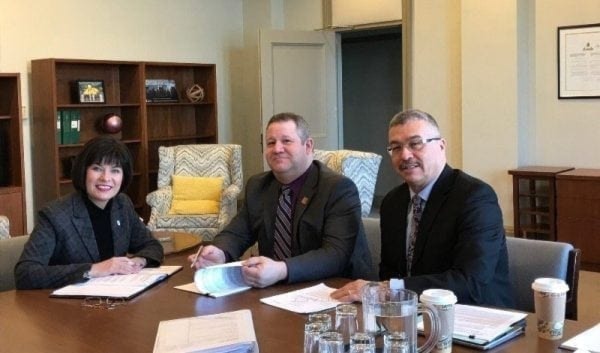Though the percentage of Indigenous children involved with the Northwest Territories' child welfare system continues to grow, the Health and Social Services minister believes the government is making progress toward reducing the number of children in care.

Glen Abernethy, the minister of Health and Social Services, centre, meets with Northwest Territories MP Michael McLeod, right and federal Health minister Ginette Petitipas Taylor during a trip to Ottawa this week.
Jan. 31, 2018
“We're on the right path,” Glen Abernethy said Jan. 29 following talks in Ottawa about First Nations, Inuit and Metis child and family services.
“We're still a ways away from where we need to be, but we're on the path that will allow us to make the appropriate improvements over time,” he said.
Territorial and provincial ministers met with Jane Philpott, the federal minister of Indigenous Services, on Jan. 25 for an “emergency meeting” about the major over-representation of Indigenous children in the child welfare system – which Philpott called a “crisis.”
“We must find ways for the removal of children in such extraordinary numbers to be stopped,” she said.
“Children should remain with their families and their kin whenever it is humanly possible.”
Philpott said policy must shift away from apprehension and toward prevention and keeping families together.
Since before confederation, Indigenous peoples in Canada have faced against extreme discrimination.
Generations of Indigenous children lived through – and many died as a result of – the brutalities of residential schools, including psychological, physical and sexual abuse.
The schools were part of the Canadian government's efforts to tamp out Indigenous languages and ways of life.
It's widely accepted that intergenerational trauma has put many Indigenous families at greater risk of involvement with child protection agencies.
In its interim report, the National Inquiry into Missing and Murdered Indigenous Women and Girls highlighted a “direct link between child welfare apprehensions and missing and murdered Indigenous women and girls.”
Though Indigenous people make up about 52 per cent of the NWT's population, in 2015-16, First Nations, Inuit and Metis children represented 97 per cent of children involved with the territory's Child and Family Services (CFS) department.
Jennie Turner, executive director of the Native Women's Association of the NWT, and her colleagues said Feb. 2 they would gladly contribute to a conversation about revitalizing the territory's child welfare system.
“We understand the realities on the street and our staff is working many hours to support these people who perhaps feel they aren't getting the support they need from government agencies,” said Turner.
“We haven't been approached lately by Child and Family Services. We would love to hear from them because we do have over 30 years' history in the territory and are informed and aware of the situation.”
Abernethy said that in the last few years, the government of Northwest Territories has tried to move away from the apprehension of children and toward preventative measures that will allow children to stay in, or be returned to, their homes.
According to the most recent annual report of the director of CFS, the proportion of Indigenous children involved with the agency is growing, but the percentage of children being removed from their homes permanently is slowly shrinking.
The percentage of children removed for up to two years, has remained relatively stagnant.
CFS states it aims to serve children in their parents' home whenever possible.
If staying home is not possible, the next option is to place the child with extended family, followed by a family in the child's home community.
In 2015-16, 28 per cent of Indigenous children involved with the system were able to live in the home of a parent.
That's up 11 per cent from ten years prior, when only 17 per cent of children receiving child and family services were living at home.
Indigenous advocates have long been vocal about inequities in the child welfare system.
Yet it took the publication in 2015 of the Truth and Reconciliation Commission (TRC) report on the legacy of Canada's residential school system to bring the over-representation of Indigenous children in care into sharp focus for governments.
The first five recommendations of 94 that were made by the TRC in 2015 relate to child welfare.
Number four calls on federal, provincial and territorial governments to “affirm the right” of Indigenous governments to establish their own child welfare agencies.
The GNWT is legally obligated to notify Indigenous governments when a child is going to be apprehended, unless the family requests otherwise.
Abernethy said that the territory would be happy to work with any Indigenous government that wishes to take over the administration of child and family services, upon conclusion of self-government and land claim negotiations.
“We're open to, and excited for, the possibilities that will bring,” he said.
All the leaders who attended the emergency meeting in Ottawa asked for money to help with child welfare in their respective jurisdictions, said Abernethy, but it's unclear whether the federal government will deliver.
Still, the NWT health minister is hopeful.
“The federal government is really recognizing that this is an area that needs to be addressed,” he said. “We're hoping that they put in some mechanisms, or maybe move forward to support some of the Indigenous people in this country to address these concerns by empowering them, and us as well.”
